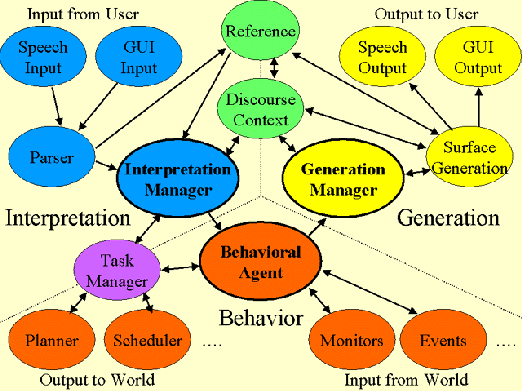3.4 TRIPS
The TRIPS system was built with an emphasis on modularity. It, therefore, consists of a number of modules that are each responsible for different tasks and inter-communicate to share the necessary information for the overall effect.
3.4.1 System Architecture
The TRIPS system was built with an emphasis on modularity.
The TRIPS (see TRIPS page) system was built with an emphasis on modularity. It, therefore, consists of a number of modules that are each responsible for different tasks and inter-communicate to share the necessary information for the overall effect. The communication is again managed by a general purpose manager. This architecture allows the extension of the system by plugging in different autonomous off-the-self resources. There are three main components that are responsible for the communication and management of the rest: The Interpretation Manager, the Behavioural Agent and the Generation Manager. They operate asynchronously.

3.4.2 Human-computer communication
There are a number of modes for the human and the computer to interact.
There are a number of modes for the human and the computer to interact. Spoken, typed, moused and menu selection input is possible. Output can be spoken or displayed. They all communicate with the chart parser and the generator.
3.4.3 The Interpretation Manager
It controls all the interpretation components.
It controls all the interpretation components. It takes as input speech acts recognised by the Parser (Section 3.4.5). It interprets the intentions of the user from those speech acts. It also coordinates reference resolution, works out discourse obligations (Section 3.4.9) and creates domain specific knowledge representation. All that is done by context information, which it gets from the Discourse Context Component (Section 3.4.8), and with domain information, which it gets from the Task Manager (Section 3.4.6).
3.4.4 The Speech recogniser
It takes speech as input and it outputs word sequences and messages to draw attention on interpretations that might need revising.
The speech recogniser takes speech as input and it outputs word sequences and messages to draw attention on interpretations that might need revising.
3.4.5 The Chart parser
It takes input from all input sources.
The chart parser takes input from all input sources. It's output is a set of speech acts, that is, an interpretation of what the linguistic form of the structure is trying to accomplish.
3.4.6 Task Manager
It turns general planning strategies to specific plans and comes up with a course of action, taking into account the user's input.
It turns general planning strategies to specific plans and comes up with a course of action, taking into account the user's input. It can make use of different resources for the planning and plan recognition depending on the needs of the domain, for example, databases, planners, schedulers.